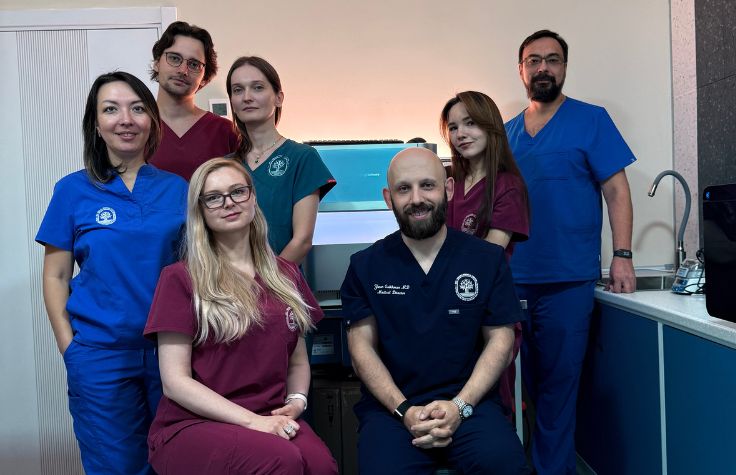
12 December 2024
Almost every country in the world has some form of newborn screening (NBS) program. However, the number and kind of medical conditions screened varies—from one to 50 or more—based on several factors. The practice began more than half a century ago with one condition, the metabolic disorder phenylketonuria. Adding new conditions to an NBS program takes time, requiring validation and policy change. But there are potentially thousands of conditions an infant could be screened for. Evolving technology, especially the ability to sequence the genome more efficiently and economically, makes screening for these conditions feasible where it was not possible before. Not only that, the number of therapeutic treatments for genetic disorders is increasing, providing an even greater impetus to screen for them before their symptoms manifest.
While no country has a government-mandated next-generation sequencing (NGS) program as first-tier testing for newborns, experts believe that such a practice could be a widespread reality in five to ten years.
Pilot studies are important for understanding how to implement the technology effectively to improve patient outcomes. In 2023, an estimated 100,000 newborns worldwide were part of an NGS newborn screening pilot program. Illumina has been involved in at least nine large-scale national and international genomic NBS studies, which screened up to 40,000 infants. This includes GUARDIAN in the US, the Generation Study in the UK, BabyScreen+ in Australia, and BabyDetect in Belgium.
Going big in the Big Apple
The first of these programs to show real data is also the largest study, with the most diverse population. Called GUARDIAN (Genomic Uniform-screening Against Rare Diseases in All Newborns), it began in 2022 in New York City with the goal of sequencing 100,000 newborns.
Interim results were recently published in Journal of the American Medical Association covering 4000 newborns. (To date they’ve screened over 14,000.)
GUARDIAN’s aim is to be equitable and broadly represent a diverse population, recruiting children from across New York City and enlisting genetic educators from various local communities. So far, about three-quarters of the families who have been approached consent to participate. GUARDIAN’s principal investigator, Wendy Chung, MD, PhD, a clinical and molecular geneticist, says that in a study like this, diversity is key. She acknowledges that without a lot of reference data for specific populations, interpreting genetic information can be challenging and time consuming: “We want to do the work—we need to do the work—and this is our opportunity to make that investment in our communities so we can be ready should policymakers want to make NBS a part of public health.”
Life-changing cases
GUARDIAN is using genome sequencing to analyze 255 genetic conditions that generally present within the first five years of life. Of these conditions, 156 have an established treatment. The study includes an optional screening for another 99 neurodevelopmental disorders with associated conditions such as epilepsy that physicians could initiate early interventions or treatments for once they’re identified.
Initially, Chung expected to get a positive result for one child in 1000, or 0.1%, but the actual rate turned out to be 3.7%. Of those who had positive results, 92% were diagnosed with a condition that traditional screening would have missed.
One baby was born with severe combined immunodeficiency, a life-threatening condition that was identified only by the GUARDIAN study. The baby had received regular NBS, but received a false negative result. “The family had absolutely no idea this was coming,” says Chung. “It was a de novo mutation, so it didn’t run in the family.” The baby went on to receive a curative bone marrow transplant. But Chung has seen such scenarios before with disadvantaged families who did not have access to sequencing. “I worry that the baby could have fallen through the cracks. We knew there was a child who died with the same exact mutation in the same exact gene.”
Rett syndrome is a genetic condition that predominantly affects girls. Similar to spinal muscular atrophy, patients start out with no visible symptoms, but their motor and language abilities later degenerate and cannot be regained. The critical window for intervention is very early. There is currently a clinical trial for genetic therapy, and an FDA-approved medication. Chung says, “Sequencing has the potential to catch this devastating disease before the girls even show symptoms, and someday I hope they will not have to go through the phase of decline.”
Surprisingly, the researchers found Rett syndrome to be five times more prevalent than predicted. “That means there are kids we’re leaving behind who are probably never getting diagnosed,” Chung says.
Long QT syndrome is an arrhythmia, or heart rhythm problem, that isn’t screened by regular NBS. The GUARDIAN study identified it in about one in 1000 births—which was again more often than expected. They checked the babies with electrocardiograms and confirmed that the genetic data was accurate. Chung is hopeful they can make these early diagnoses and prevent associated outcomes, like sudden infant death syndrome (SIDS).
A positive result for a condition does not necessarily mean the treatment or intervention will be an enormous or costly undertaking. Chung says that even simple measures, like avoiding medications that could worsen symptoms, or starting an inexpensive, well-tolerated oral medication, can make a difference.
Genomics England’s ambitious project
In the UK, Chung had been talking to Genomics England about a nationwide program well before GUARDIAN launched. In 2019, a committee came together to explore whether it was feasible and desirable to use whole-genome sequencing as an adjunct to NBS. In 2021, the UK government elected to fund a program to screen 100,000 newborns for conditions that must be treated very early on. That same year, David Bick, MD, PhD, joined Genomics England as the principal clinician on the project, called the Generation Study. “This was the first time that a national health care service was engaging in a research project this large and specifically for newborns,” he says. They identified a list of more than 200 conditions to screen for (most of which have an orthogonal confirmatory test), with about 460 genes on the panel.
The aims of the Generation Study are threefold: To determine whether whole-genome sequencing will result in better outcomes for the children, to use the anonymized data (with parental consent) for ongoing research into diagnostics and therapies, and finally, to one day understand if having a child’s genomic data would be helpful across their lifespan.
Not all NBS programs are built the same. The UK’s differs in method, protocol, gene list, and so on, down to the very sampling itself. The Generation Study is using umbilical cord blood for the samples, rather than the blood spot card. If the team identifies a genetic variant, a clinical scientist reviews and signs the report, before notifying an appropriate specialist who calls the newborn’s family (for example, a hematologist if it’s a blood disorder, or a nephrologist if it’s a kidney problem). They had to put pathways in place to manage patients once a variant is detected. Bick says this is very different from many programs around the world “where the entire program is run, if you will, from a genetics group—like GUARDIAN.”
To date, they have recruited more than 2250 individuals and are starting to return results. Currently they have about 19 participating trust hospitals but plan to expand to 30 or 40 sites. Genomics England screens for only those disorders where the treatment is available and approved in the UK. Thus it allows for equitable access to appropriate follow-up through the National Health Service (NHS).
Given the variability, Bick says, “each country has to think about its own medical system and population. What will work in the UK will not work in the US, and vice versa.” Along with the science and technology, one of the most important factors to take into consideration is the families. “The first thing I say to myself is, ‘What do the parents want?’”
Sharing knowledge and best practices
Bick is an adamant proponent of ICoNS—the International Conference on Newborn Sequencing—and he presented at its meeting in New York City this October. This year’s conference attracted clinicians, researchers, policymakers, hospital administrators, and others from more than 50 countries. ICoNS has created work groups to discuss areas in need of alignment, such as gene lists and the logistics of data sharing. Bick says, “It’s only through sharing that we really will be able to move the field forward—and save a lot of children’s lives.”
Another consortium for NBS in Europe, called Screen4Care, is gathering support; groups in Italy, France, the Netherlands, Germany, and Denmark are all preparing projects as well. Programs are already underway or in planning stages in Australia, New Zealand, Korea, Taiwan, and Qatar. Russia recently issued a publication on NBS, and China has published nine papers by various groups.
In the US, Chung—who was appointed the chair of Pediatrics at Boston Children’s Hospital and Harvard Medical School in July 2023—is examining the feasibility of an NBS program in Massachusetts. In the meantime, the GUARDIAN researchers are continuing on the path to 100,000 babies and are sharing their experience for the benefit of other states and countries. “Hopefully, that way we’re all getting smarter faster,” she says.
Bick explains that the next three or four years will be about data and outcome collection: “It’s fine to find a child with a treatable condition and get the treatment underway, but we also need to know one to three years after we started treating that child whether their outcome was better than if we had waited for the disease to show up.” Of course, detection before the child becomes sick is preferable, since for some conditions, waiting for symptoms to present themselves may render gene therapy less effective.
“Virtually all of the conditions on our list, or anybody’s list, have never been screened for in a newborn setting. Never,” Bick says. “What’s wonderful about Wendy’s [GUARDIAN] paper is that she’s providing real data on real outcomes of real patients.
“My plea is for people to share data,” he continues. “But my other plea is that people need to be very vigilant about trying to track outcome.” He points to Robin Hayeems’s Clinician-reported Genetic testing Utility InDEx (C-GUIDE), which has shown to help programs assess their clinical utility.
Genomics England is working with health economists to determine whether they will save money for the conditions they find. They’ll measure the NHS resources they use, the time and cost for clinical scientists to find variants and review results, and how many doctor’s visits were scheduled because of the findings.
Until he has the data, Bick will continue driving the Generation Study forward on the conviction that it can help children. “Whole-genome sequencing is such an important technology and development in this field,” he says. “For me personally, this has been the most interesting, rewarding project I’ve worked on in my entire medical career. Because I see this as a way to really help thousands and thousands of children worldwide. That’s what my career has been about.” ◆


